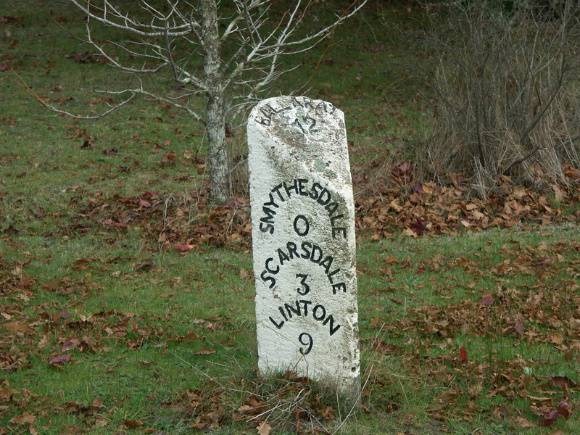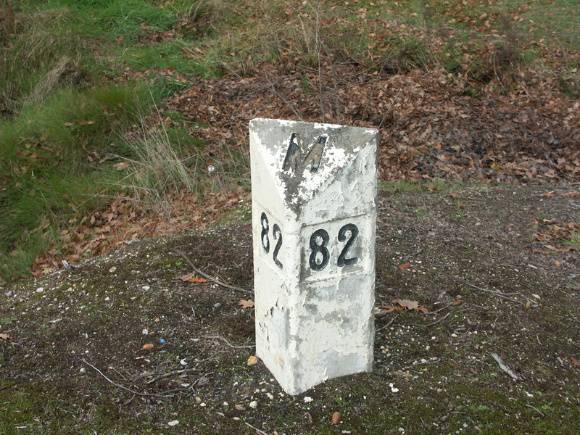| Back to search results » | Back to search page » |
|
Stone Mileposts
LocationGlenelg Highway and Ballarat-Skipton Road, SMYTHESDALE, Golden Plains Shire LevelRegistered |
|
Statement of Significance
National Estate Register:
The stone mileposts on the Glenelg Highway between Scarsdale and Ballarat are of historical significance for
their association with the development of early Victoria. Road construction was accelerated following the
economic boom of the gold rushes in Victoria and the mileposts were a direct response to this, trying to
rationalise the road system of a developing colony. The stone mileposts between Scarsdale and Ballarat assist
in a greater understanding of the development and impact of 19th century economic activity in the State and
the resultant need for transport systems. The mileposts on the Glenelg Highway between Scarsdale and
Ballarat are a visual reminder of the evolution of Victoria's infrastructure and the past imperial system of
measurements and weights. The milesposts are of historical importance for their ability to describe transport
routes and requirements of the 1870s.
The removal of the mileposts, and their respective re-instatement, is of historical significance. After the fall of
Pearl Harbour in 1942, most mileposts were dug up and buried a few meters behind their original location;
most were re-instated into their original locations in 1946. The mileposts were removed or hidden in an attempt
to thwart enemy forces in the event that Australia was invaded. This act symbolises what was a national
psychological response to a major world crisis and a reaction to particular events outside Australia's national
boundaries.
The stone mileposts between Scarsdale and Ballarat are architecturally significant as good examples ofstonemason's art and their simple but elegant shape is aesthetically pleasing. The structures are typical of a
vernacular stonemason's tradition. The mileposts are among a group of rare surviving examples of stone
mileposts in Australia.
This place is entered in the Victorian Heritage Register and the statement above has been provided by
Heritage Victoria.
The Australian Heritage Commission recognises the standards of historic assessment of Heritage Victoria and
acknowledges that this place has national estate historic values. Enquiries concerning the assessment or
conservation of this place should be directed in the first instance to Heritage Victoria.
Commonwealth authorities and bodies should contact the Australian Heritage Commission directly if any
Commonwealth action is proposed in relation to this place.
Source: Victorian Heritage Register
The bluestone mileposts along the Glenelg Highway between Scarsdale and Ballarat were installed prior to the
1870s and are linked to the development of the Cobb & Co routes. The bluestone mileposts predate the first
cast iron posts and are an intact and visual reminder of the imperial measuring system previously operating in
Australia. The posts consist of triangular bluestone posts with a shaved top and all have been painted in recent
years. The rear face of the posts is rounded. The stone milesposts read (B1): Ballarat 13 - Scarsdale 2 - Linton
8; (B2): Ballarat 12 - Smythesdale 0 - Scarsdale 3 - Linton 9; (B3): Ballarat 11 - Smythesdale 1 - Scarsdale 4 -
Linton 10; (B4):
Ballarat 4 - Smythesdale 8 - Scarsdale 11 - Linton 17 and (B5): Ballarat 3 - Smythesdale 9 - Scarsdale 12 -
Linton.
The stone mileposts on the Glenelg Highway between Scarsdale and Ballarat are of historical and architectural
significance to the State of Victoria.
The stone mileposts on the Glenelg Highway between Scarsdale and Ballarat are of historical significance for
their association with the development of early Victoria. Road construction was accelerated following the
economic boom of the gold rushes in Victoria and the mileposts were a direct response to this, trying to
rationalise the road system of a developing colony. The stone mileposts between Scarsdale and Ballarat assist
in a greater understanding of the development and impact of 19th century economic activity in the State and
the resultant need for transport systems. The mileposts on the Glenelg Highway between Scarsdale and
Ballarat are a visual reminder of the evolution of Victoria's infrastructure and the past imperial system of
measurements and weights. The milesposts are of historical importance for their ability to describe transport
routes and requirements of the 1870s.
The removal of the mileposts, and their respective re-instatement, is of historical significance. After the fall of
Pearl Harbour in 1942, most mileposts were dug up and buried a few meters behind their original location;
most were re-instated into their original locations in 1946. The mileposts were removed or hidden in an attempt
to thwart enemy forces in the event that Australia was invaded. This act symbolises what was a national
psychological response to a major world crisis and a reaction to particular events outside Australia's national
boundaries.
The stone mileposts between Scarsdale and Ballarat are architecturally significant as good examples of
stonemason's art and their simple but elegant shape is aesthetically pleasing. The structures are typical of a
vernacular stonemason's tradition. The mileposts are among a group of rare surviving examples of stone
mileposts in Australia
Group
Transport - Road
Category
Road Milepost/Milestone







